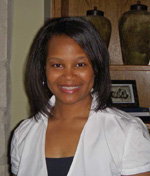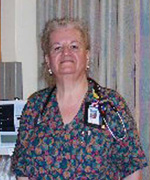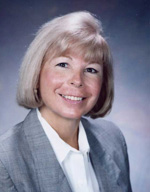Reaching Out to “Invisible Heroes”
On the Job Healing
By Teddi Fine

Each morning, Tracie Kirkland rises and heads off to work at the Pepsi bottling plant near her Dallas, Texas, home. But the clinical nurse practitioner doesn’t join the assembly line—she reports to the plant’s Wellness Center, where she provides occupational and primary health care to more than 465 employees. The center is one of 15 operated in Pepsi Bottling Group facilities by the Johns Hopkins Health, Safety and Environment program.
“I’ve been able to bring my everyday experience as a nurse practitioner and my passion for primary care into a totally different environment and still do what I love the best,” says the Virginia native.
The Wellness Center that Kirkland runs is part of an entrepreneurial effort by Ed Bernacki, MD, MPH, director of the Johns Hopkins Hospital Division of Occupational Medicine, to export the Johns Hopkins occupational health model to the Pepsi Bottling Group and other parts of corporate America.
Kirkland, who jokingly calls herself “a one-woman shop who does it all,” is the first line of care for a worker injured on the job and the last person to assess fitness to return to work. In addition to seeing 12 to 15 employees a day, she manages disability and workers’ compensation claim communications, performs routine drug screens for new employees, and conducts employee wellness seminars and health screening. Flu shots are routine, and she has piloted a family flu shot program.
“I’m able to provide comprehensive care, including routine wellness and prevention services like hypertension and diabetes testing,” says Kirkland, who earned both her adult (’96) and pediatric (’98) clinical nurse practitioner post-master’s degrees at the school. “Those are services that just don’t happen in traditional occupational health clinics. And we’re looking for ways to grow the program even more, maybe by better integrating mental and physical health into our wellness work.”
As a primary care nurse, Kirkland sees an important benefit to providing health care services in the workplace. The Wellness Center “enables workers to access health care sooner than they otherwise might,” she notes. “People don’t always take the time they need to stay healthy. Thanks to the center, they can take that time for themselves and for their health while on the job, and that’s a very good habit to learn.”
She Comes Equipped
By Kelly Brooks-Staub

Jennie Bono ’66 is known throughout the MedSurg Unit at Seattle’s Highline Medical Center for always having the tool that’s needed. Co-workers jokingly refer to the “fanny pack” she carries around her waist as her “carry-on” or her “tumor”! Here, she describes her assortment of nursing supplies, stored in the pack’s many different slots and pockets:
- Stethoscope (“Littman is the best and I lend it only to the doctors whom I’m certain will return it”)
- bandage scissors
- extra scissors for cutting flower stems
- at least 2 pairs of hemostats (good for separating IV tubing sections as needed
- “mini-mag” flashlight (for pupil checks
- several pens
- small calculator (for totaling intakes and outputs)
- 2″x2″ gauze packages
- betadine swabs
- rolls of 1″ tape
- 2 types of end connectors and caps for IV tubing
- labels for IV tubing
- a bag of rubber bands and safety pins
- a little bottle of ibuprofen (“for me and my friends”)
- a couple of holders that accommodate prefilled narcotic or antiemetic cartridges for giving those medications into IV lines
- alcohol swabs (“just in case I run out of the handful of them I put in my shirt pocket every day”)
“All this saves a million trips to the supply rooms,” Bono says. On the outside of the waist pack, she carries a small opener for soda cans, a locator badge so she and the other nurses can “find” each other on a screen connected to the desk phones, and a key to open PCA pumps (connected to patients’ IV lines to deliver “patient-controlled analgesia” cartridges of morphine).
“You can see why I take it off during lunch or the rare morning break,” Bono says. “I leave it with my ‘brains’—a clipboard that holds my census sheets, my worksheet with reminders of what I have to accomplish all day, my written report for end of shift—and sit down as much as I can to do the charting, of which there is plenty!”
^top
Reaching Out to “Invisible Heroes”
By Teddi Fine

After a severe illness left his father wheelchair-bound, in constant pain, and unable to control his bowel or bladder, Brian* has become his father’s overnight caregiver while his mom, a nurse, works the night shift. The burden of meeting his dad’s physical and emotional needs every night leaves him little time for dating, a part-time job, or socializing with friends. And he struggles with guilt if he sleeps through the bell system he created for his father to wake him when needed.
Brian has been filling this caregiver role for four years; he just turned 18. Brian is just one of an estimated 1.4 million young people nationwide who currently provide significant regular assistance to a member of the household who has a short- or long-term illness or disability. It’s a group of caregivers that Connie Siskowski ’67, PhD, describes as “invisible heroes.” Her goal: to bring help and hope to youth like Brian, who have gone too long being unrecognized and unaided.
A former critical care and cardiac nurse, Siskowski first recognized the need of young caregivers after establishing a Florida support service, Volunteers for the Homebound and Family Caregivers of Boca Raton. Research she conducted concluded that more than half the 12,500 students in public middle and high schools in Palm Beach County have the dual roles of student and caregiver. Of that group, two-thirds miss school and after-school activities, fail to complete homework, and are interrupted in their studying or work life, Siskowski reported in a recent article in the Journal of School Nursing.
“These youth experience many of the same stresses, social difficulties, health problems, and personal losses as adult caregivers. And they do it at a much younger age, when learning, developing, and socializing are so important,” Siskowski observes. “Support mechanisms exist for young people when they experience a death of a family member, but what about the time, and often an extended time, when family health issues and care-giving responsibilities affect their learning and their lives?”
Today Siskowski is leading the search for answers. She helped establish the American Association of Caregiving Youth to educate families, health and social service providers, teachers, and the public about the issues that can affect care-giving youth. Her Caregiving Youth Project is piloting models, some new, some adapted from other countries, to identify young caregivers and to assess and address their academic, emotional, social, and health needs. Models include ways to provide respite and fun time for student caregivers, improve care-giving skills and communication, enhance linkages between care-giving youth and resources they need, and help educators improve opportunities for youth who are family caregivers. She hopes that successful models will be adopted and adapted elsewhere across the country.
“My dream is for the needs of family caregivers of all ages to be identified at the point of diagnosis and before a person is discharged from a hospital to home,” Siskowski says. “Just as employers assist employees who do double duty as family caregivers, I hope that, with the right tools, communities will recognize, reach out, and support care-giving youth to safeguard their physical and mental health, their schooling, and their futures.” After all, she says, “Their future is our future.”
^top